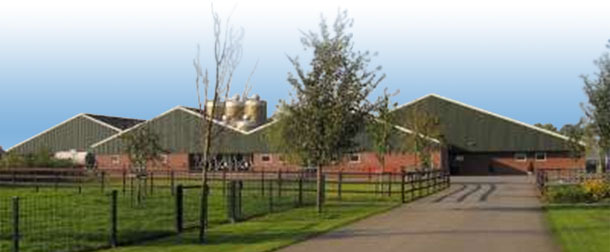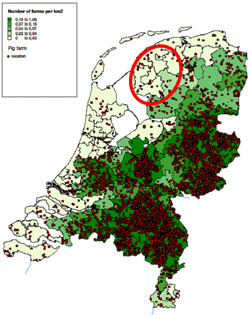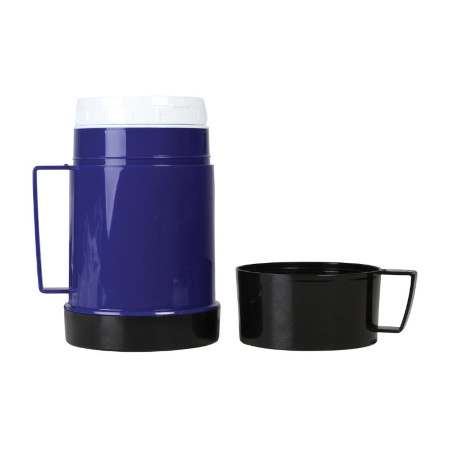PRRSV is known around the world by causing many disease outbreaks and endemic infections. The costs of the disease have been calculated in the US, the Netherlands, Denmark and Sweden. Costs per sow in acute outbreaks range from around 100€ in Europe, to over 200 € in the US. Recent calculations from Denmark show that the yearly financial loss for the Danish swine industry, caused by endemic or chronic PRRSv-infections, is around 15 million € in the most probable scenario (ranging from 4 – 43 million € depending on different assumptions) . The total cost for the US swine industry was estimated to be 530 million € each year. But it’s not only the financial impact of PRRS-infections. Other reasons to take action are: the frustration of reoccurring PRRS outbreaks in spite of vaccination, restrictions for the use of antibiotics in several European countries as the Netherlands, Denmark and Sweden, and the demands from export markets for pigs and pork. All these arguments together have led to the decision taken in the Netherlands to take action on the control of PRRS.


What’s in the toolbox to battle PRRS in regional programs?
From the research in the US it has become clear that there are effective tools to be used on farms for several goals: diminishing disease signs and impact of disease, eliminating the virus, or keeping the virus out. These tools include high levels of biosecurity, herd closure, vaccination and air filtration. Experiences in the field both the US and other parts of the world, underline the value of these tools. But, in daily practice most farmers simply will not be able to apply all these tools at once, including air filtration, the latter being necessary to counter aerosol spread of PRRSv. And this is where the regional approach comes in: joint action with all farmers in a region. To say it differently: “If you do not filter incoming air, your farm status will be dictated by your neighbors’ status! ”.
The Dutch program: priorities and first results
 Fig 1: Distribution of pig farms in the Netherlands and PRRSv Project area in the Netherlands (red circle) |
The Dutch program started in January 2013, in the northern region of the Netherlands (see figure 1). The Product Board for Meat and Livestock finances the monitoring and coaching. Seventy-two farms joined the program, about 75% of the farms in that region. Twenty percent are commercial sow herds, 25% are farrow to finish, 55% are finishing herds. An area of low pig density was chosen, to lower the risk of airborne or neighborhood infections. The first goal of the project is to control PRRSv-infections in order to produce negative offspring. Therefore, the program aims at diminishing the transmission of the virus not only between farms (external biosecurity) but also within farms (internal biosecurity: reducing the number of contacts of an animal with another possibly infectious animal, both directly and indirectly). For an optimal implementation of the advised measures an independent and experienced coach visits the farms on a regular basis, not only to coach the farmer but also the veterinarian (train the trainer). The coaching program is implemented on 39 of the 72 farms. The other farms are either owned by the same farmers or receive piglets from one of the coached farms. For each farm a tailor made plan with prioritized actions is written, focused on progress in both internal and external biosecurity, including the possibility of herd closure. Air filtration and vaccination will not be applied as a general rule but only in specific cases, and if the farmer is willing to invest in these tools. On all 72 farms weaners or finishers are sampled for serological testing. On farrow to finish farms both animal groups are sampled. Sows are not sampled in the current initial phase of the project. Before the project started the farm statuses were unknown. To measure whether or not there is active virus circulation on the farm, blood samples are taken every 4 months; 20 samples from 9 week old weaners are tested by PCR, 10 samples from 22 week old finishers are tested by ELISA. The third round (after 1 complete year of blood sampling) is now completed on all 72 farms that are taking part in the program.
So far, results of blood testing are promising, several farms have tested negative three times in either 20 weaners or 10 slaughter age finishers, or even in both age groups.
In case of negative test results, actions are focused on strengthening external biosecurity to prevent virus introduction and maintain the negative status. In case of positive test results additional emphasis is put on blocking internal virus circulation by both management and internal biosecurity measures.
Challenges for the swine industry are of course the management of hygiene in pig transport, rendering, and PRRS-status of incoming pigs in the project area. These topics will be addressed by the steering committee in charge of the project. Within the program research will be done concerning inactivation of PRRSv on transport trucks using high temperatures. A few boar studs in the Netherlands have a PRRS-unsuspected status and are able to deliver semen from PRRS-unsuspected boar studs to farms in the region where the PRRS program is running. The unsuspected status of these boar studs is the assigned status after having tested them every month without finding antibodies so far (100% of the boars are tested every year).
Other regional control programs in Europe
During Euro PRRS 2013, the meeting of the European COST action held last October in the city of Heraklion on Crete, an overview of European activities and projects was presented. Besides the Netherlands regional control programs have started in Spain (1 project running, 3 more to come in 2014), France and Slovenia. Other countries are considering organized control: Denmark, Northern Ireland and Ireland. Main elements used in the current regional projects, as they are running now, are different for each project, ie coaching and frequent monitoring (in The Netherlands), monitoring and/or eradication (in France), and the use of an Alert Network to inform vets on new outbreaks (in the pig dense region of Catalonia in Spain).

Initiatives on national level in Europe
Two European countries are planning to take action on national level. In Hungary legislation has been issued on January 16th 2014, demanding strict regulations for the importation of breeding pigs (including quarantine) and fatteners (only from virus free herds). The Hungarian legislation also defines a standard for pig and farm PRRSv status including regular serological testing. Lastly PRRSv eradication will be started in Hungary in regions with low pig density. In Denmark the government is gathering now the relevant elements for a national eradication program.
Comparing US versus Europe
The US has a long history with regional projects to eliminate PRRSv. Starting in Stevens County, Minnesota, in 2004, there are now around 25 regional projects running. Of course situations are different from each other: the US type 2 PRRSv strains are causing more outbreaks and leading to greater losses, compared to the European type 1 strains. This might result in a lower motivation of European veterinarians and farmers to act against PRRS. But let’s not forget the recently found strains of high pathogenicity in Eastern Europe and Belgium. PRRS-viruses will certainly change and will certainly surprise us with high pathogenicity, even in Western Europe!







